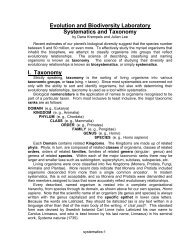Biodiversity Data Analysis: Testing Statistical Hypotheses
Biodiversity Data Analysis: Testing Statistical Hypotheses
Biodiversity Data Analysis: Testing Statistical Hypotheses
You also want an ePaper? Increase the reach of your titles
YUMPU automatically turns print PDFs into web optimized ePapers that Google loves.
df = degrees of freedom<br />
s 2 = variance<br />
the number of independent quantities in a system<br />
a measure of individual data points' variability from the mean<br />
s = standard deviation the positive square root of the variance<br />
To calculate the mean weight change of either the treatment or control group, the<br />
investigators simply sum the weight change of all individuals in a particular group and divide it<br />
by the sample size.<br />
n<br />
_<br />
Σ x i<br />
x = i=1<br />
n<br />
Thus calculated, the mean weight change of our Fat-B-Gon tm control group is 4.74 kg, and of<br />
the treatment group, 7.34 kg (Table A2-1).<br />
To determine the degree of the subjects' variability from the mean weight change, the<br />
investigators calculate several quantities. The first is the sum of squares (SS) of the<br />
deviations from the mean, defined as:<br />
_<br />
SS = Σ ( x - x i ) 2<br />
Whenever there is more than one test group, statistics referring to each test group are given a<br />
subscript as a label. In our example, we will designate any statistic from the control group with<br />
a subscript "c" and any statistic from the treatment group with a subscript "t." Thus, sum of<br />
squares of our control group (SS c ) is equal to 27.92 and SS t is equal to 29.86 (Table A2-2).<br />
The variance (s 2 ) of the data, the mean SS of each test group, is defined as:<br />
Calculate the variance for both the treatment and control Fat-B-Gon tm groups. Check your<br />
answers against the correct ones listed Table A2-2.<br />
Standard deviation (s), the square root of the variance:<br />
Calculate the standard deviation for the treatment and control groups. Check your answers<br />
against the correct ones listed in Table A2-2.<br />
B. Parametric tests<br />
A parametric test is used to test the significance of continuous numerical data (e.g. -<br />
lizard tail length, change in weight, reaction rate, etc.). Examples of commonly used<br />
parametric tests are the Student's t-test and the ANOVA. Your biodiversity data are likely to be<br />
non-parametric, but if you do have parametric data, you should already be familiar with the use<br />
<strong>Biodiversity</strong> – <strong>Data</strong> <strong>Analysis</strong> 4

















